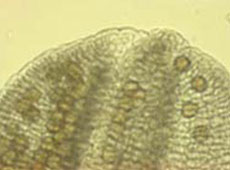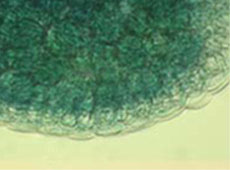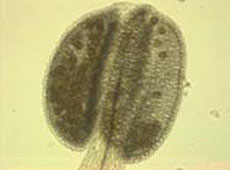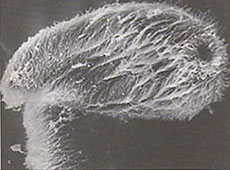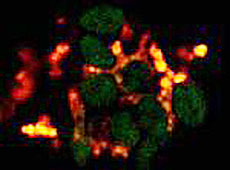Begriffe in der Endozytobiologie (Englisch)
biont (Hawksworth 1988): Biological system with the ability of genetically independent reproduction (genetically autonomous biological system).
Cavalier-Smith Demand: Gene transfer from symbiont to host changes the symbiont into a cell organelle (Cavalier-Smith and Lee 1985, Bayer and Schenk 1986, Schenk 1990)
cell organelle: cell compartment with distinct functions (normally surrounded by at least one envelope membrane) composed also by proteins of which at least some are encoded in the nucleus of the GHRS.
complex cell: a "chimeric" cell, composed by two or more taxonomically different cells, with partially or totally fused genomes.
complex plastid: phyletic secondary or tertiary plastid, an exogenosome (see e.g. Schenk 1994b).
cyanelle: genetically autonomous, symbiotic living cyanobacterium (like a zoochlorella, Pascher 1929: "Cyanelle bezeichnet eben eine endosymbiontisch lebende Blaualge gegenüber der freilebenden. Cyanelle soll so wenig ein systematischer Begriff sein wie Zoochlorelle und Zooxanthelle"). The term should not more be used for the photosynthetic chromatophores of Glaucocystophyta which are plastid like cell organelles (see cyanoplasts).
cyanome (Pascher 1929): symbiotic consortium of host and (intracellular) cyanobacterium ( = cyanelle).
cyanoplast (Schenk 1990): eukaryotic, photo(hydro)trophic cell organelle (chloroplast), with regard to distinct cyanobacterial characteristics obviously originating from a former cyanelle by IITC.
dibiont (Hawksworth 1988): symbiotic consortium of two bionts, e.g. a dibiontic lichen (myco- and phycobiont).
dyssymbiosis (Schaede 1962): parasitic association.
endocytobiology (Schwemmler 1980, Smith et al. 1984, Schenk 1993a,b): science of cytobioses, exogenosomes and exogenons, including related symbiotic, evolutionary and phylogenetic fields.
endocytobiont: facultative or obligate intracellular symbiont (genetically autonomous biont).
endocytobiontology: partial discipline of symbiological research dealing with the biology of intracellular symbionts (endocytobionts).
endocytobiosis (Schwemmler 1979, Taylor 1979): intracellular association of two cells. Endocytobiosis is called homologous if both cells derive from the same taxon or same biont (like e.g. synergides in the makrogametophyte of seed plants), or heterologous if partner cells come from different taxa (see symbiosis). This special symbiotic association has the facultative ability to an evolutionary change (by IITC) of a dibiont-system into a new monobiont-system bearing a new cell organelle, the exogenosome.
endogenon: (phylogenetic term) autonomously (by direct filation) evolved gene or gene fragment.
endogenous (or autogenous): phylogenetic term used for cell properties which have evolved in dependence on the own genetic possibilities of the cell (contrast: exogenous).
endogenosome (phylogenetic term, Schenk 1992a): usually membrane enveloped cell organelle with an endogenous (autogenous) origin.
EST: Endosymbiosis Theory (Margulis 1970, 1981, e.g. Dodge 1980, Sitte 1983)
eusymbiosis: mutualistic association (Schaede 1962).
exogenon: (phylogenetic term) exogenously - (e.g. by horizontal gene transfer) - acquired genetic information: single whole gene, gene cluster or spliced gene fragment, which latter could lead to the formation of hybrid proteins.
exogenous: used as phylogenetic term for cell properties of a biont originating from a biont of a different (or of the same) taxon.
exogenosome (phylogenetic term, Schenk 1992a): per definitionem a cell organelle (containing DNA or not), descending of a former (endo)cytobiont, which finally and irreversibly has been come under the cybernetic cell control of the genomic hypersystem (GHRS) by IITC
genomic hypersystem: see GHRS.
genomic hyposystem: see GHOS.
GHOS: (phylogenetic term), the 'genomic hyposystem' looses genes under the influence of another genome during phylogenesis: a) by deletion, b) by gene transfer towards a partner genome (GHRS).
GHRS: (phylogenetic term, Schenk 1993a), the 'genomic hypersystem' is in case of gene transfer the main receiver genome.
gnorimobiont: symbiont which is recognized during the infection of the host (or during endocytosis by the host) and received by the host accompanied by mutual processes (e.g. Rhizobium and Fabales) (Schenk 1993a).
IITC: see: inequal (inaequalis, unequal) intertaxonic combination.
inequal intertaxonic combination (IITC): the observed gene transfer (combined with other necessary processes) goes mainly from the GHOS (e.g. endocytobiont) towards the GHRS (e.g. host nucleus) (this "endocytobiological rule" was firstly expressed by Sitte 1991). IITC is changing a dibiont towards a monobiont system.
intertaxonic combination (ITC, Sitte 1991): intracellular processes (including gene transfer) changing a symbiotic consortium towards a new taxon by irreversible combination (mixing) of the original symbiotic genomes. In addition to mutation and recombination the ITC is the third evolutionary process which can change the genotype (Sitte 1991), it is an until now not understood macromechanism.
ITC: see: intertaxonic combination.
macromechanism, evolutionary (Schwemmler 1989): evolutionary reaction complex (e.g. ITC) leading to new taxa.
metaguest: GHOS, metahost : GHRS (Schenk 1992b); see also: Cascade of new taxa.
SET: Serial Endosymbiosis Theory (Taylor 1974, Margulis 1981, 1988, Whatley 1980).
symbiogenesis (Mereschkowsky 1905, 1910): a) evolution of a symbiotic consortium by two steps. Step I: Installation of a facultative symbiosis, e.g. endocytobiosis with formation of a symbiosome. Step II: 'Stabilization' of the facultative consortium (step I) towards an obligate symbiosis, e.g. with transmission of the endocytobiont from one to the following generation. b) Exogenosome formation (symbiogenesis step III): Origin of a new organism (taxon) by IITC of two symbiotic partners.
symbiosis: "... Zusammenleben ungleichnamiger Organismen ..." (de Bary 1879), the permanent or long-lasting (Smith and Douglas 1987) association of differently named bionts. This broad definition includes both mutualistic and (in contrast to the usual language) parasitic associations. The intracellular symbiosis is a special form of symbiosis (see endocytobiosis). In accordance with this definition 'symbiosis' can be only 'heterologous' (see endocytobiosis).
symbiosome (Park and Jeon 1988): double enveloped cell compartment, composed by the endocytobiont (symbiont) with its plasmalemm (as inner envelope) and an outer envelope (the symbiosome membrane), also called perisymbiontic (e.g. perialgal, peribacteroid) membrane. Symbiosomes can be newly formed, artificially or naturally, dependent on the ontogenetic stage of the partners, or can be transmitted from one to the next generations.
xenosome (Soldo 1983): sensu stricto obligate, infectious bacterial endocytobiont in the cytoplasm of the philasterine marine prototozoan Parauronema acutum, (sensu lato, Corliss 1985: organism or body, within a eukaryotic cell, that must contain DNA and is bounded by at least one membrane).
References
Bary, A. de, 1879. Die Erscheinung der Symbiose. Verlag Trubner, Straßburg.
Bayer, M.G., Schenk, H.E.A. 1986. Endocytobiosis & Cell Res. 3:197.
Cavalier-Smith, T., Lee, J.J. 1985. J. Protozool. 32:376.
Corliss, J.O. 1985. J. Protozool. 32:373-376.
Dodge, J.D. 1980. In: (W. Schwemmler and H.E.A. Schenk, eds.) Endocytobiology (I), W. de Gruyter, Berlin, New York, pp. 33-50.
Hawksworth, D.L. 1988. Bot. J. Linn. Soc. 96:3-20.
Margulis, L. 1970. Origin of eukaryotic cells. Yale University Press, New Haven.
Margulis, L. 1981. Symbiosis in Cell Evolution, 419 pp., Freeman & Co., San Francisco.
Margulis, L. 1988. Serial endosymbiotic theory (SET): Undulipodia, mitosis and their microtubule systems preceded mitochondria. Endocytobiosis & Cell Res. 5:133-162.
Mereschkowsky, C. 1905. Biol. Zentralbl. 25:593 ff.
Mereschkowsky, C. 1910. Biol. Zentralbl. 30:278 ff.
Park, M.S., and Jeon, K.W. 1988. Endocytobiosis & Cell Res. 5:215-224.
Pascher, A. 1929. Jahrb. Wiss. Bot.71:386-462
Schaede, R., 1962. Die pflanzlichen Symbiosen (Meyer, F.H., ed.). Fischer, Stuttgart.
Schenk, H.E.A. 1990. In: (P. Nardon et al., eds.) Endocytobiology IV, INRA Paris, pp. 199-209.
Schenk, H.E.A. 1992a. Endocytobiosis & Cell Res. 8:215-222.
Schenk, H.E.A. 1992b. In: (A. Balows et al., eds.) The Prokaryotes. Springer Verlag, New York, Berlin, pp. 3819-3854.
Schenk, H.E.A. 1993a. In: (S. Sato, M. Ishida and H. Ishikawa., eds.) Endocytobiology V, pp. 547-556.
Schenk, H.E.A. 1993b. ISE News Letters/ISEG Brief I/93:11-16.
Schenk, H.E.A. 1994a. Endocytobiosis & Cell Res. 10:87-106.
Schenk, H.E.A. 1994b. In: (J. Seckbach, ed.) Evolutionary pathways and enigmatic algae: Cya-nidium caldarium (Rhodophyta) and related cells. Kluwer Academic Publishers, Dordrecht, Boston, London, pp. 19-52.
Schwemmler, W. 1979. Mechanismen der Zellevolution, 276pp.,W.de Gruyter, Berlin.
Schwemmler, W. 1980. In: (W. Schwemmler & H.E.A. Schenk, eds.) Endocytobiology (I), W. de Gruyter, Berlin, New York, pp. 943-967.
Schwemmler, W. 1989. Symbiogenesis, a macromechanism of evolution, 226 pp.. W. de Gruyter, Berlin, New York.
Sitte, P. 1983. In: (H.E.A. Schenk, W. Schwemmler, eds.) Endocytobiology II. W. de Gruyter,
Berlin, New York, 101-119.
Sitte, P. 1991. BIUZ 21:85-92.
Sitte, P. 1993. In: (S. Sato, M. Ishida and H. Ishikawa., eds.) Endocytobiology V, pp. 557-558.
Smith, D.C., Douglas, A.E. 1987. The Biology of Symbiosis. Edward Arnold, Caulfield East, V 3145, Australia
Smith, D.C., Schwemmler. W., Schenk, H.E.A. 1984. Endocytobiosis & Cell Research 1:III-VI.
Soldo, A.T. 1983. Int. Rev. Cytol. Suppl. 14: 79-109.
Taylor, F.J.R. 1974. Taxon 23:229-258.
Taylor, F.J.R. 1979. Proc. R. Soc. London Ser. B 204:267-286.
Whatley F.R., Whatley J.M. 1980. In: (W. Schwemmler & H.E.A. Schenk, eds.) Endocytobiology (I), W. de Gruyter, Berlin, New York, pp. 849-865.
